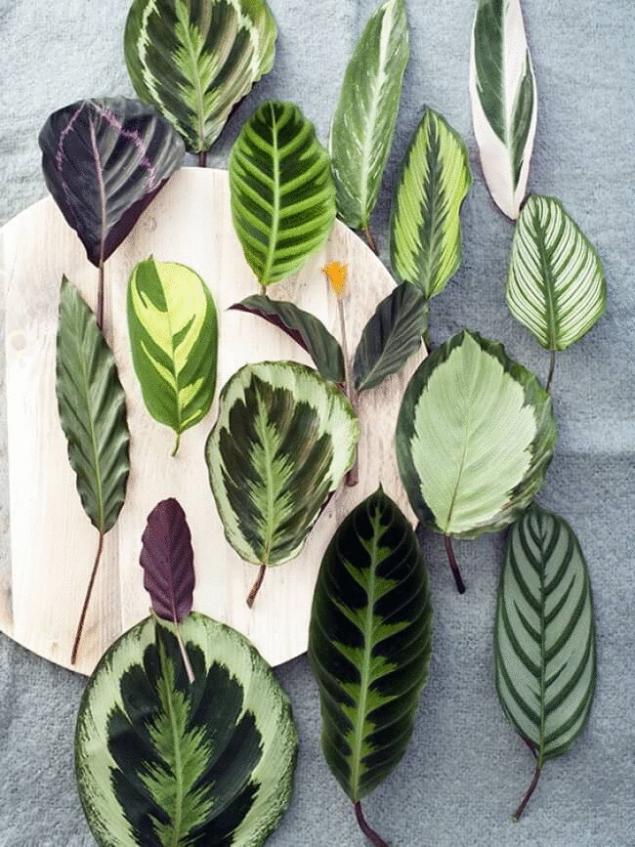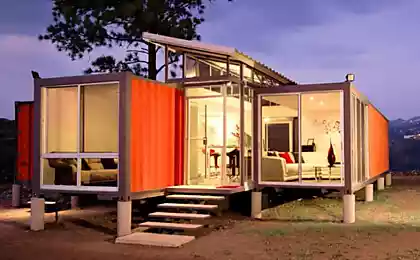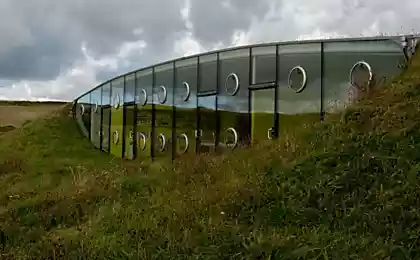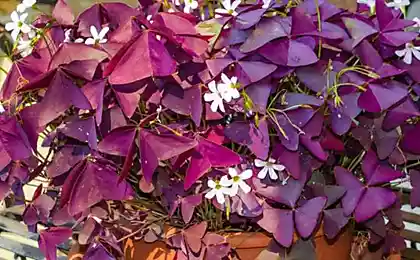797
Calathea – arrowroot beauty at your home
This plant can grow only experienced gardeners, as the plant is quite demanding in care.
Calathea is a herbaceous rhizomatous perennial plant, and belongs to the family marantaceae. In natural conditions calathea native to tropical South America. There are about 130 species of this plant.

Plant height may be in the range from 30 to 80cm.Calathea popular due to its beautiful leaves, in some species the leaves reach a length of 30cm. Leaf shape is usually oval or elongated oval, they can grow on stalks and immediately from the root.
A distinctive feature of this plant is that its leaves always turn towards the sun. The flowers of the plants can be different colours represent inflorescences spike-like or rounded shape.
Calathea species
Calathea Bahema
This kind came to us from Brazil. Leaves of plants of this species are basal, lanceolate, can reach a length of 35 cm and a maximum width of 10 cm the leaf coriaceous, thick, leaf color is quite bright silvery-green background there are dark green spots. The flowers have the shape of the ear.
Calathea Of Parshevica
This species can be attributed to the most common types of this plant on our window sills. Leaves petiolate, oval-shaped, velvety. The color of leaves is quite interesting from the bottom they are dark Burgundy and the upper plate is dark green with light green splotches. Flowering inflorescences in the form of a spike, the flowers are quite beautiful and powerful, can be white, pink or cream color.
Calathea wonderful lancifolia
This kind of more nazyvatelnaya lantsetolistnyj. This species is very beautiful due to their unusual leaves.
The long narrow leaves have a wavy edge, grow on stalks of medium size, smooth, without edges. Bright colors on a light green background scattered light green large and small spots. The back side of the leaf purple. The leaves grow up to 30cm in length and 5-6cm wide. The flowers are collected in spike inflorescence.
Calathea zebrina
The name of the species says about the color of its leaves, the bright green background scattered Cirrus bands of various forms, in appearance, the color of the leaves resembles the skin of a Zebra, only in shades of green. The underside of the leaf has a reddish-pink color. Leaves have an elliptical shape that grow up to a length of 40cm and a width of up to 15-17cm. Inflorescences spicate, can be both white and blue.
Calathea leopard
The name of this species, as the previous one, talking about the colors of the leaves, they look like leopard skin, but in shades of green. The view can be attributed to the medium. The leaves have a lanceolate shape, length of adult leaf reaches 15-20cm and width 5cm, leaves grow on pretty long stalks. Inflorescence spike-like, yellow in color.
Kalateya Mako
One of the most common types of calathea. The Mature plant grows up to 50cm in height. Leaves rather broad, oval-shaped, grows up to 20-25 cm in height and 10-12 cm in width.
Popular plant due to its exceptional decorative leaves. The area of the sheet is so white that it seems translucent, lined with bright green stripes, veins, long dark green stripes and red spots, of different shapes.
Calathea Rufibarba
The popular name of this Qalat – Redbeard is the name of the plant received light reddish edge on the lower stone of the leaf and petioles. Leaf shape oblong, wavy edge, leaf color can vary from light green to dark green, without a pattern.
Calathea Medallion
Leaves of plants of this species are broad oval, formaI appearance resemble a medallion.The sheet surface is very bright and beautiful, on a bright green background lined with pink lines. The back side is dark pink.
Kalateya decorated
The species belongs to the low Qalat, as an adult plant can grow to 35-40cm in height. Leaves petiolate, petiole length very rarely exceeds 15cm. The leaves themselves have an elliptical shape that grow up to a length of about 20cm and a width of about 6cm.
The leaves of calathea very decorative, background, leaf yellowish-green, grayish-silver and pink lines on the sides. The underside of the leaf purple. Inflorescences spicate, can be both white and purple. The most popular varieties of this species can be considered rosealeta Kalat and Kalat of sanderiana
Kalateya saffron Krokat
This kalateya saffron called for bright yellow blossoms. Blossoms long and often. The flowers are very beautiful in appearance resemble the double varieties of lilies. The plant grows up to 70-90 cm in height.
Plant leaves are usually dark green, lower side of the leaf is dark brown, oval with a slightly wavy edge.
Calathea care in the home
The plant is very capricious and fastidious care, it is growing only by a professional florist. How to care for calathea to please you and decorate your home will tell you our recommendations.
Temperature mode
The plant prefers moderate temperature in summer and winter from 16 to 24⁰ C. if the room temperature is higher 24⁰ need to introduce a regime of high humidity, otherwise the plants begin to dry the leaves.
Desirable to prevent the lowering of the temperature regime below 16⁰, although a short time the plant can be located and at temperatures up to 10⁰ C. the Main thing is to remember that sudden temperature changes and drafts are detrimental to the plant.
Lighting and location
Calathea plant is tolerate growing in the shade, but do not take her to the darkest corner of the room, as being there for a long time, the plant will lose the diversity of color of the leaves, the leaves will begin to shrink and the plant will slow growth. Too bright rays will not benefit the calathea leaves can start to curl and lose color, and contact sheets to direct sunlight and is fraught with burns. Ideal can be regarded as conditions of partial shade and diffused light.
Watering
The plant should be watered to defend water at room temperature or slightly warmed. Well suited the plant is warmed melt water. Calathea loves abundant watering, but after watering need to wait until you drain the excess moisture and drain it from the pan. If not can rot the roots, as the plant does not tolerate stagnant water.
In the summer you should enter the mode of irrigation once in 3-4 days, winter watering should be reduced to once in 7-8 days. The soil should dry out slightly between waterings, but not dry.
Water the plant very carefully so that water droplets falling on the leaves.
Humidity
As the plant came to us from the tropics, it needs high humidity. Ideal is a humidity of 90%, but unfortunately at home this humidity to achieve is quite difficult. If you grow Qalat in an apartment, try often to wipe the leaves and spray the plant, but it can be done, if you have a plant with smooth leaves. If the sheets are formed drops of water, they should be wet with a damp sponge, otherwise the leaves will appear dark spots. The plant should be sprayed only with warm water.
If you have a plant with velvety pubescent leaves, it is impossible to spray, and the humidity to increase or by using trays with water or using a humidifier.
Feeding
The plant should be feed in the period from April to September, you need to use a liquid fertilizer for decorative-deciduous plants. Feeding is produced once in two weeks. Feeding produce strictly according to the instructions, the plant does not tolerate excess nutrients in the soil.
Soil
The soil for planting calathea needs to be breathable. Ideally you can consider the following composition of the substrate: 2 parts leaf or sod land, 1 part peat, 1 part sand, polcast charcoal.
Calathea transplant
The plant is recommended to repot every year or two, to make the procedure preferably in the spring. Recommended transplanting plants method of handling that would be less damaging root system. Pot for transplanting choose to 3-5cm in diameter more than the previous one.
Before transplanting, take care of the drainage layer, it needs to be at least 3cm. Then the plant is removed from the old pot and installed in the new, and the void is filled with fresh soil.
Reproduction
These plants are propagated by dividing the Bush, to separate the baby can when transplanting. For this after removing the plant from the pot, the young plant is separated with a sharp tool. The main thing that the baby was separated together with the root, and don't forget to sprinkle fresh cut charcoal.
Young plants should be planted in small pots and care for.
Calathea disease
Most diseases in plants occur due to improper care, consider the main problems with the plant.
Problem: calathea – dry and curl the leaves
This issue occurs due to insufficient air humidity or contact with plants under the cold air.
Problem: leaves turn yellow
In this case, you should perform which of the following troubles has undergone a plant is exposed to cold air, was long in dry air, overfilling, underfilling, excess fertilizers.
Problem: the leaves are stretched out and became thin
In this case, the cause of the problem can be considered the lack of lighting, move the plant to a brighter place.published
P. S. And remember, only by changing their consumption — together we change the world! ©
Source: www.art-pen.ru/
Calathea is a herbaceous rhizomatous perennial plant, and belongs to the family marantaceae. In natural conditions calathea native to tropical South America. There are about 130 species of this plant.

Plant height may be in the range from 30 to 80cm.Calathea popular due to its beautiful leaves, in some species the leaves reach a length of 30cm. Leaf shape is usually oval or elongated oval, they can grow on stalks and immediately from the root.
A distinctive feature of this plant is that its leaves always turn towards the sun. The flowers of the plants can be different colours represent inflorescences spike-like or rounded shape.
Calathea species
Calathea Bahema
This kind came to us from Brazil. Leaves of plants of this species are basal, lanceolate, can reach a length of 35 cm and a maximum width of 10 cm the leaf coriaceous, thick, leaf color is quite bright silvery-green background there are dark green spots. The flowers have the shape of the ear.
Calathea Of Parshevica
This species can be attributed to the most common types of this plant on our window sills. Leaves petiolate, oval-shaped, velvety. The color of leaves is quite interesting from the bottom they are dark Burgundy and the upper plate is dark green with light green splotches. Flowering inflorescences in the form of a spike, the flowers are quite beautiful and powerful, can be white, pink or cream color.
Calathea wonderful lancifolia
This kind of more nazyvatelnaya lantsetolistnyj. This species is very beautiful due to their unusual leaves.
The long narrow leaves have a wavy edge, grow on stalks of medium size, smooth, without edges. Bright colors on a light green background scattered light green large and small spots. The back side of the leaf purple. The leaves grow up to 30cm in length and 5-6cm wide. The flowers are collected in spike inflorescence.
Calathea zebrina
The name of the species says about the color of its leaves, the bright green background scattered Cirrus bands of various forms, in appearance, the color of the leaves resembles the skin of a Zebra, only in shades of green. The underside of the leaf has a reddish-pink color. Leaves have an elliptical shape that grow up to a length of 40cm and a width of up to 15-17cm. Inflorescences spicate, can be both white and blue.
Calathea leopard
The name of this species, as the previous one, talking about the colors of the leaves, they look like leopard skin, but in shades of green. The view can be attributed to the medium. The leaves have a lanceolate shape, length of adult leaf reaches 15-20cm and width 5cm, leaves grow on pretty long stalks. Inflorescence spike-like, yellow in color.
Kalateya Mako
One of the most common types of calathea. The Mature plant grows up to 50cm in height. Leaves rather broad, oval-shaped, grows up to 20-25 cm in height and 10-12 cm in width.
Popular plant due to its exceptional decorative leaves. The area of the sheet is so white that it seems translucent, lined with bright green stripes, veins, long dark green stripes and red spots, of different shapes.
Calathea Rufibarba
The popular name of this Qalat – Redbeard is the name of the plant received light reddish edge on the lower stone of the leaf and petioles. Leaf shape oblong, wavy edge, leaf color can vary from light green to dark green, without a pattern.
Calathea Medallion
Leaves of plants of this species are broad oval, formaI appearance resemble a medallion.The sheet surface is very bright and beautiful, on a bright green background lined with pink lines. The back side is dark pink.
Kalateya decorated
The species belongs to the low Qalat, as an adult plant can grow to 35-40cm in height. Leaves petiolate, petiole length very rarely exceeds 15cm. The leaves themselves have an elliptical shape that grow up to a length of about 20cm and a width of about 6cm.
The leaves of calathea very decorative, background, leaf yellowish-green, grayish-silver and pink lines on the sides. The underside of the leaf purple. Inflorescences spicate, can be both white and purple. The most popular varieties of this species can be considered rosealeta Kalat and Kalat of sanderiana
Kalateya saffron Krokat
This kalateya saffron called for bright yellow blossoms. Blossoms long and often. The flowers are very beautiful in appearance resemble the double varieties of lilies. The plant grows up to 70-90 cm in height.
Plant leaves are usually dark green, lower side of the leaf is dark brown, oval with a slightly wavy edge.
Calathea care in the home
The plant is very capricious and fastidious care, it is growing only by a professional florist. How to care for calathea to please you and decorate your home will tell you our recommendations.
Temperature mode
The plant prefers moderate temperature in summer and winter from 16 to 24⁰ C. if the room temperature is higher 24⁰ need to introduce a regime of high humidity, otherwise the plants begin to dry the leaves.
Desirable to prevent the lowering of the temperature regime below 16⁰, although a short time the plant can be located and at temperatures up to 10⁰ C. the Main thing is to remember that sudden temperature changes and drafts are detrimental to the plant.
Lighting and location
Calathea plant is tolerate growing in the shade, but do not take her to the darkest corner of the room, as being there for a long time, the plant will lose the diversity of color of the leaves, the leaves will begin to shrink and the plant will slow growth. Too bright rays will not benefit the calathea leaves can start to curl and lose color, and contact sheets to direct sunlight and is fraught with burns. Ideal can be regarded as conditions of partial shade and diffused light.
Watering
The plant should be watered to defend water at room temperature or slightly warmed. Well suited the plant is warmed melt water. Calathea loves abundant watering, but after watering need to wait until you drain the excess moisture and drain it from the pan. If not can rot the roots, as the plant does not tolerate stagnant water.
In the summer you should enter the mode of irrigation once in 3-4 days, winter watering should be reduced to once in 7-8 days. The soil should dry out slightly between waterings, but not dry.
Water the plant very carefully so that water droplets falling on the leaves.
Humidity
As the plant came to us from the tropics, it needs high humidity. Ideal is a humidity of 90%, but unfortunately at home this humidity to achieve is quite difficult. If you grow Qalat in an apartment, try often to wipe the leaves and spray the plant, but it can be done, if you have a plant with smooth leaves. If the sheets are formed drops of water, they should be wet with a damp sponge, otherwise the leaves will appear dark spots. The plant should be sprayed only with warm water.
If you have a plant with velvety pubescent leaves, it is impossible to spray, and the humidity to increase or by using trays with water or using a humidifier.
Feeding
The plant should be feed in the period from April to September, you need to use a liquid fertilizer for decorative-deciduous plants. Feeding is produced once in two weeks. Feeding produce strictly according to the instructions, the plant does not tolerate excess nutrients in the soil.
Soil
The soil for planting calathea needs to be breathable. Ideally you can consider the following composition of the substrate: 2 parts leaf or sod land, 1 part peat, 1 part sand, polcast charcoal.
Calathea transplant
The plant is recommended to repot every year or two, to make the procedure preferably in the spring. Recommended transplanting plants method of handling that would be less damaging root system. Pot for transplanting choose to 3-5cm in diameter more than the previous one.
Before transplanting, take care of the drainage layer, it needs to be at least 3cm. Then the plant is removed from the old pot and installed in the new, and the void is filled with fresh soil.
Reproduction
These plants are propagated by dividing the Bush, to separate the baby can when transplanting. For this after removing the plant from the pot, the young plant is separated with a sharp tool. The main thing that the baby was separated together with the root, and don't forget to sprinkle fresh cut charcoal.
Young plants should be planted in small pots and care for.
Calathea disease
Most diseases in plants occur due to improper care, consider the main problems with the plant.
Problem: calathea – dry and curl the leaves
This issue occurs due to insufficient air humidity or contact with plants under the cold air.
Problem: leaves turn yellow
In this case, you should perform which of the following troubles has undergone a plant is exposed to cold air, was long in dry air, overfilling, underfilling, excess fertilizers.
Problem: the leaves are stretched out and became thin
In this case, the cause of the problem can be considered the lack of lighting, move the plant to a brighter place.published
P. S. And remember, only by changing their consumption — together we change the world! ©
Source: www.art-pen.ru/























